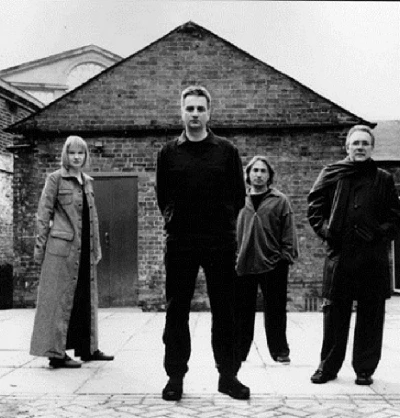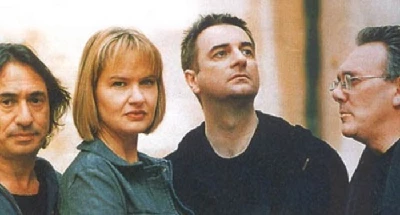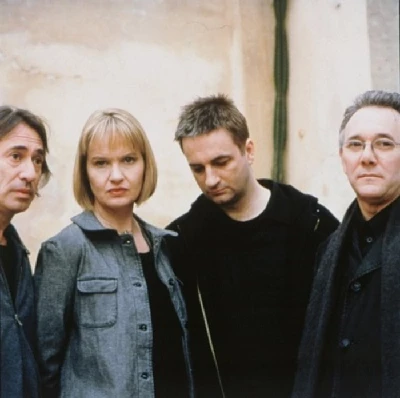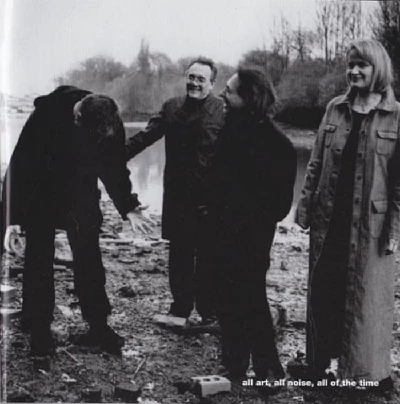Art Of Noise
-
Interview with Gary Langan
published: 24 /
2 /
2014

Paul Waller chats to Gary Langan from 80's synthpop pioneers the Art of Noise about his lengthy production career and his influential band's career
Article
Frankie Goes To Hollywood may have been the runaway success story that sprung from the ZTT label in the early to mid-80’s, but it was the Art of Noise who were the label’s true flagship band, If you could call them a band at all, as to be honest they didn’t call themselves a band either. The Art of Noise were more like a DIY collective of like-minded thinkers and producers that did for electronic music what many people have done since but nobody did before. Well, not to any successful degree.
Gary Langan was one of these producers. Not only did he create some of the greatest tunes that spewed forth from the 80’s, but he went on to have great success with many other artists work sitting behind the mixing desk.
Thankfully the fact that ZTT are celebrating their thirtieth anniversary has given Pennyblackmusic the opportunity to speak one on one with Gary about his lengthy career within the music industry and of course forming the one and only Art of Noise.
PB: What is your earliest musical memory? What was it that made you think, “Hang on… I love music”?
GL: Well, it was the third Yes album (Simply titled ‘The Yes Album’ -Ed), and tracks like ‘Yours is No Disgrace’ and ‘The Clap’. I just had a little Dansette record player and very little pocket money, and somehow through school at about the age of fourteen somebody gave me this Yes album and I went, “Oh, My God”.
Before that I had a father who was a professional musician, so I had been trawled around recording studios where there were just these engineers in white jackets who would sit in a control room. So, from the ages from about ten or eleven that’s what I would do during the school holidays. The other choice was to follow my mother around in her hairdressing shop and earn some pocket money sweeping up hair and whatever, or I could hang on to Dad’s shirt tails and go to these things called sessions, and he was doing programmes like ‘Music While You Work’ and things like that for the BBC Home Programme which would be broadcast live, and I used to sit on these things, and so I ended up working in the studio.
PB: A lucky call then that you didn’t hang out with your mum. Things could have turned out very different.
GL: Ha, ha, Oh darling! Whether I would be another Vidal I will never know.
PB: It’s incredible to think that you went from falling in love with music via a Yes album to actually working with them. You must have been ecstatic?
GL: Yes, I was because they were one of the seminal bands for me.
PB: To come from a rock music fuelled background is not what you would expect when you think of the Art Of Noise.
GL: We dispel that kind of thought but I think that you really shouldn’t work with your heroes. Now I won’t tell you the whole truth because the whole truth is boring, but I worked with my heroes. I worked with Yes. They were the thing that dragged me into this but there were various factions of it that made me think… “Well, you’ve let me down. You know you were my heroes, and now I have worked with you. Now you’re not.”
PB: It’s inevitable that when you work with your idols that they will become more human. There was no choice. It had to happen.
GL: I had no choice either… I was working with Trevor Horn. I was stuck working with them. Saying that it was amazing though, the first time that The Fish (Chris Squire, founding member of Yes - PW) came down, it was because Trevor wanted him to play bass on a Buggles track called ‘I am a Camera’ that then became a Yes track. So The Fish came down and I was like, “Oh my god, you are my hero.” It’s a strange feeling.
PB: What was it that made you want to put the music together, engineering and producing rather than playing an instrument as your primary niche?
GL: Because I learned at an early age that I hated performing. Whether it be at some Wimbledon music festival that I was put up to play at the age of eight or nine or whether it be the Royal College exams, you are on a stage and I just thought, “This is shit. There has got to be something better than this.”
I think all of us do not and did not then enjoy being in front of a camera. As a band in the Art of Noise we never saw ourselves as the new ‘boy band’ or anything. We were not cut out for that. We just made this music, and it sort of worked. The three of us had this wonderful and bizarre eclectic chemistry. I mean maybe I shouldn’t speak for the other two, but I did not enjoy being in the front of the camera. You can probably tell that because there is only one video that the three of us appear in. I am talking about “the three of us” because really Trevor and Paul came on board that little bit later after it had all started.
PB: Before we go further in depth with Art of Noise I’d like to talk about some of the projects you worked on before you formed the group. For instance. you played a large part in the creation of one of my all-time favourite albums, Malcolm McLaren’s ‘Duck Rock’.
GL: Knitting fog.
PB: What?
GL: Knitting fog. Think about it. It was the most bizarre album ever made. But what a fantastic journey I had. It was just I had no idea what the hell we were doing. Trevor sort of did because he was at the helm, but Malcolm would just plug ideas from the ether.
It was such a fantastic journey, and I was there from day one until the bitter end.
PB: It’s one of those rare records from that time that still holds up well today. Those radio snippets between songs seem dated yet clever now, but back then it sounded mad.
GL: That was genius. That’s what made that album what it was.
PB: I was nine when I first heard it. I’d discovered pop music only a year before that.
GL: (Laughs) You were nine! My god, and then you heard ‘Duck Rock’! That must have been so, so bizarre. It was bizarre for everybody involved so if you were a nine year old…I don’t know. It must be like someone coming across a Stanley Kubrick movie at that age, or the equivalent of you sitting down and watching ‘Blade Runner’ or something really odd like that.
‘Duck Rock’ should almost be a university piece with what is actually going on in that culturally. It is quite fantastic, it really is, but how it got finished I just don’t know.
PB: You also worked on more mainstream things like remixing Nik Kershaw’s great ‘Wide Boy’ single. Was that sort of project just paying jobs for you?
GL: No, I was a staff engineer at the time and there were two of us. The guy who did the main mixes was a guy called Julian Mendelsohn. Now the producer Pete Collins really, really loved this little studio in the East End of London called Sarm, and that was where a lot of things really started for me. So, I was a staff engineer with this little Aussie guy Julian, and I got called in on that.
A funny story about Nik Kershaw is that my wife who I didn’t know at the time was Nik Kershaw’s fashion stylist, and then she became the fashion stylist for Pepsi and Shirley, and designed all those puff ball dresses that Shirley wore. So, I got set up on this blind date with the fashion stylist for Pepsi and Shirley who then became my wife. She designed Nik Kershaw’s snood, so it’s like three degrees of separation.
PB: You also worked on PiL’s ‘Happy’ album, and this was also one of those landmark records for me, what are your memories of that one?
GL: It’s a great album with some great tracks on it. There really is. If you are a real heavy Pil. Fan, then, okay, it was a little bit different as it was the first album where John (Lydon - PW) had allowed girl backing vocalists, and we had a huge argument over it. On every PiL album before that there were no female vocals. Now John became a really good friend, but bearing in mind that with John you have to work at gaining his trust there was this little period where I said that I knew some great backing vocalists, and he just said, “You ain’t fucking doing that. Not on my fucking album.” And I would say, “Well, actually, I am, John.” “Well, you can just fuck off!” and so it went on…and he stormed out, and I didn’t see him for three or four days, maybe even a week, so I just though, “Sod it!” and put the girls on. It was a weird album that one.
PB: Songs like ‘The Body’ come alive because of those backing vocals.
GL: Yeah, it’s fantastic and John loved it in the end, but he had to eat humble pie and to make Lydon eat humble pie is a truly tricky thing.
PB: It’s a risky business.
GL: Very risky.
PB: So, let’s talk about the Art of Noise. It’s pretty much well known that the seeds were sewn to create the Art of Noise during a session with Yes. They discarded a drum riff that you loved, and from that short riff you and J.J. Jeczalik created a whole new song and more importantly began to form a whole new style of music. What I am wondering is what was it that made you see the magic in that drum pattern in the first place?
GL: Well, yet again I was working again with my heroes in Yes, I ended up doing two albums with them and we were doing ‘90215’, and we were in this amazing studio in London’s Oxford Circus and they cut this track, and the drums just sounded like cannons, and I thought that it was bloody amazing. Bearing in mind that this was around the same time as Bowie’s ‘Let’s Dance’ and ‘In the Air Tonight’ by Phil Collins was coming out, I just thought with this drum sound that I was in here, that I would be in the top 5 here but then they scrapped the track. I was like, “WHAT!”
Because I was the curator of the multi-track tapes on this album, and by this time there must have been around sixty or seventy reels of multi-track tape nobody knew what was on what tape, except for me. Now Trevor used to have this thing he did. In fact he still does today where if he is working on something but it just isn’t working then he will just erase it. I have done this many, many times working with Trevor but this was the one time where I thought “Sod that! Nobody needs to know and I’m just going to keep that, hold that one back. One more reel to reel tape was not going to make any dent in the budget, so I squirrelled this thing away for months.
At one point we were kind of seeing blue men climbing up green walls because we had been in so many studios, and J.J. and I had been in the thick of it this whole time. Now I don’t know why I remember this. but I think it was on a Thursday afternoon and they all left us around five or six o’clock, so J.J. was packing up ready to go and I was like, “Oi, where do you think you’re going? You ain’t going nowhere.”
Now we had use of this thing called a Fairlight and I don’t know where it came from, but I had this idea that we could maybe squeeze in a whole drum kit into this computer and see what it squished out the other end. J.J. looked at me as if I was nuts but I said that’s why we were there. So, we did it and we ended up staying up all night like the Blues Brothers, him saying, “No, we can’t do that,” and me going, “Yes, we can.”
PB: They were such clunky and time consuming things; it must have taken for ever?
GL: Oh it did, it was bonkers, absolutely bonkers but that’s what you need to do. It’s what the kids don’t do now, and it really hacks me off that they don’t push any boundaries and they don’t stick their foot out. You have to make big strides. You can live and die by them, but I had this idea to try something that had never been done before. We had been fooling around with sampling, and I was slowly learning what it was possible to get out of this machine, which was the start of it.
PB: It does seem odd that today a person can fire up their computer, within seconds sample some drums and half an hour have a rough song completed. Many people don’t realise the massive and long winded processes involved and leaps of faith that working with Fairlight technology took in the early days.
GL: No, they don’t. They have no idea.
PB: So after that did you keep it quiet, I take it you had to finish off the album. It must have been maddening knowing what you had?
GL: Yeah, we kept it quiet, kept it schtum. All I had was a cassette of what we had turned out on that night.
PB: Was the Art of Noise even an idea in your head at this point?
GL: No, not at all. It was the early 80’s and technology was bursting. It really was. You had the Lynn drum machine, the TR808 and you had those first inklings of sequencers. It maybe wasn’t like the birth of a universe, but it was the birth of a star. Yeah, for where technology is now back then that was the birth of the star that is now the sun.
PB: It was an odd way to begin, and yet within the space of two years you went from being simply the engineer to being a founder of a band that wasn’t really a band and yet was getting records out there and having some generous success to boot. Was it overwhelming or were you gung-ho and riding the wave?
GL: How mad is that, eh? Yeah, gung-ho, that was the attitude. Also at that same time was the birth of ZTT, so there was quite a few things that were getting locked in place. It was this great, fantastic and wonderful period in my life where is just seemed to stumble forward and we made these records. In some respects it was a little like the rebirth of Motown. It was a label where you seemed to be able to get everything from it, and it was a label where we were the first band signed and the first band to leave. I always say be the first or the last, but don’t muck about in the middle because nobody remembers the middle man. Everybody remembers who came first and who came last.
It was an odd thing to experience; I don’t think it was JJ’s idea at first to be in a band. He was going to be a geography teacher. Did Anne Dudley ever want to be in a band? Hmm…Possibly not. Did I? No, I had no idea what it was about but it was one of those periods in one’s life where certain things were occurring and it was happening, it was rolling so you just sort of go with it. Did I ever see myself appearing on ‘Top of the Pops’ or ‘The Tube’? Definitely not, no, not in a million years.
PB: My first knowledge that the Art of Noise existed like many others was watching the ‘Close (To the Edit)’ video on ‘The Chart Show’ one Saturday morning.
GL: It is just so over the top and it is scary as hell. What’s more Trevor and Paul Morley were of the “Oh no, no, that’s too this or that’s too that” opinion. I can’t remember what the technique is called, but it was all very stop framed, very staccato. I thought it was absolutely amazing, completely nuts; that little midget girl chain-sawing away and dressed up all sadomasochistic, c’mon! It was a fantastic video, it really was.
PB: Looking back are you content with the body of work you produced? Some of those tracks you were not so heavily involved with did you think they were not up to scratch?
GL: Yes, I do think that at some point the Art of Noise went off the rails, and it lost its point of contact. Now that’s not a criticism. It’s a statement and a personal statement at that, but I also believe that project scenarios have a start and middle and an end, and I thought there was an end to the Art of Noise but clearly not.
PB: You left the band at one point. Was it internal politics or did you just think that the group was no longer what you wanted to do?
GL: It was a bit of both to be quite honest; we had an injunction out on us from ZTT, so that we were not allowed to sign to any label in the UK or within its territories so we were stuffed. We went through the courts and the high courts with ZTT and we won our case. and all three of us put a lot of money on the line but we won, so we then signed to China Records. But I had sort of been a bit beaten up by the whole court case.
Now there was this thing where we were about to go on tour, and present the band in this one way, and I was like “No, no, no. We the Art of Noise; we just don’t do that sort of tour. If we go on the road, then we have to do something really bonkers. Having done ‘Duck Rock’ and hanging around with Malcolm, I came away from it with many things, and he taught me this one great phrase. “People get confused with won’t and can’t”. Most people say that they won’t do something; it’s not that they can’t do it. Malcolm taught me you can do absolutely anything that you want to, but most people won’t because they think they can’t.
I thought that we should play Manhattan, we should play Chicago and we should play Los Angeles, and the management team were asking how we were going to do that.
So, I thought we should put ourselves in one club like Danceteria in New York, and we could get video DJs or VJs as they were called, and we could get a short wave camera link to four or five other trendy clubs around Manhattan and because none of us were stars, none of us look particularly great on camera, why couldn’t we play on the Andy Warhol thing that everyone should be famous for so many minutes of their life? So, we would have a hub set up in Danceteria and we could have these short wave TV and audio links from other clubs that we could beam out to, then we could have had roving cameras in these clubs that could make somebody a star for three minutes of their lives. Finally these VJs could mix it all together. The manager just thought that it would cost loads and I said, “Yeah, it is, it’ll cost shit loads but we can go to Panasonic, we can get sponsorship. Let’s really push the boat out.” It all got a bit angry so I just said, “Look you guys, I am out and I don’t want to do it anymore.”
PB: That ethos of pushing it, which got the Art of Noise where they were, was gone then?
GL: Exactly, that’s why I bowed out.
PB: Finally then, even after the way it ended, when you look back now how do you remember your time in the Art of Noise?
Nobody ever did it with the thought that there would be some kind of legacy. I would never have thought that this many years down the line that I would still be talking about it. But I am happy to be. It was a lot of fun. It really was.
PB: Thank you.
Pennyblackmusic will be publishing an interview with J.J. Jeczalik about his years in the Art of Noise next month.
Picture Gallery:-


